
The Coppa Ciano was an automobile race held in Italy. Originally referred to as Coppa Montenero or Circuito Montenero, the Coppa Ciano name was officially in use between 1927 and 1939.

The Coppa Ciano was an automobile race held in Italy. Originally referred to as Coppa Montenero or Circuito Montenero, the Coppa Ciano name was officially in use between 1927 and 1939.

During the years immediately following World War I several road circuits were created in Italy. These included the Montenero Circuit at Livorno, which became home for the annual Coppa Montenero from its inauguration in 1921. In the beginning it was only a local affair and the organizers quickly found themselves in financial troubles. In 1923 the event was taken over by the Automobile Club of Italy and the future was secured.
In 1927, the Livorno-born politician Costanzo Ciano donated a victory trophy: the Coppa Ciano. At first, this was awarded to the victor in a separate sports car race, run within a week of the Coppa Montenero. In 1929, however, the Coppa Ciano was merged into the main event and at the same time became the name most often used.
The driver Emilio Materassi won 4 years in a row 1925-1928 and earned the nickname "King of Montenero".
In the 1930s, Italian Hall of Fame driver Tazio Nuvolari won this race five times, more than any other driver. In his 1936 victory he made his way through the field, beating the otherwise superior German cars. This victory was one of the reasons leading to the Italian Grand Prix being held at the Montenero circuit in 1937, instead of the usual venue, Monza.
The 1939 race was run to Voiturette regulations and became the last before World War II stopped all racing for many years. In 1947 the 20th and final edition of the Coppa Montenero was run, with 1500 cc unsupercharged cars. At that point, due to Costanzo Ciano's connections with the now abolished Fascist regime, it was no longer called Coppa Ciano.
| Year | Race Name | Dist. | Circuit | Formula | Driver | Manufacturer | Time | Report |
|---|---|---|---|---|---|---|---|---|
| 1927 | VII Circuito Montenero | 225 km | 22.5 km | Formula Libre | | Bugatti T35C | 2:45:18 | Report |
| I Coppa Ciano (Sport) | 225 km | 22.5 km | Sports car | | Alfa Romeo 6C-1500 | 2:52:42 | Report | |
| 1928 | VIII Circuito Montenero | 225 km | 22.5 km | Grand Prix | | Talbot 700 | 2:38:57 | Report |
| II Coppa Ciano (Sport) | 225 km | 22.5 km | Sports car | | Alfa Romeo 6C-1500 | 2:52:42 | Report | |
| 1929 | III Coppa Ciano (Circuito Montenero) | 225 km | 22.5 km | Grand Prix | | Alfa Romeo P2 | 2:38:51 | Report |
| 1930 | IV Coppa Ciano (Circuito Montenero) | 225 km | 22.5 km | Grand Prix | | Maserati 26M | 2:33:50 | Report |
| 1931 | V Coppa Ciano (Circuito Montenero) | 200 km | 20.0 km | Grand Prix | | Alfa Romeo 8C 2300 Monza | 2:23:40 | Report |
| 1932 | VI Coppa Ciano (Circuito Montenero) | 200 km | 20.0 km | Grand Prix | | Alfa Romeo Tipo-B 'P3' | 2:18:19 | Report |
| 1933 | VII Coppa Ciano (Circuito Montenero) | 240 km | 20.0 km | Grand Prix | | Maserati 8CM | 2:45:08 | Report |
| 1934 | VIII Coppa Ciano (Circuito Montenero) | 240 km | 20.0 km | Grand Prix | | Alfa Romeo Tipo-B 'P3' | 2:49:52 | Report |
| 1935 | IX Coppa Ciano (Circuito Montenero) | 240 km | 20.0 km | Grand Prix | | Alfa Romeo Tipo-B 'P3' | 2:42:08 | Report |
| 1936 | X Coppa Ciano (Circuito Montenero) | 216.5 km | 7.218 km | Grand Prix | | Alfa Romeo 8C-35 | 1:44:54.4 | Report |
| 1937 | XI Coppa Ciano (Gran Premio d'Italia) * | 360.0 km | 7.218 km | Grand Prix | | Mercedes-Benz W125 | 2:44:54.4 | Report |
| 1938 | XII Coppa Ciano (Circuito Montenero) | 232.0 km | 5.80 km | Grand Prix | | Mercedes-Benz W154 | 1:00:35.2 | Report |
| XII Coppa Ciano (Circuito Montenero) | 145.0 km | 5.80 km | Voiturette | | Maserati 6CM | 1:05:21.6 | Report | |
| 1939 | XIII Coppa Ciano (Circuito Montenero) | 348.0 km | 5.80 km | Grand Prix | | Alfa Romeo 158 | 2:30:10.4 | Report |
| * (AIACR European Driver Championship round) [1] - Sources: [2] [3] [4] [5] [6] [7] [8] [9] [10] [11] [12] [13] [14] [15] [16] | ||||||||

Tazio Giorgio Nuvolari was an Italian racing driver. He first raced motorcycles and then concentrated on sports cars and single-seaters. Originally of Mantua, he was nicknamed Il Mantovano Volante and Nuvola ("Cloud"). His victories—72 major races, 150 in all—included 24 Grands Prix, five Coppa Cianos, two Mille Miglias, two Targa Florios, two RAC Tourist Trophies, a Le Mans 24-hour race, and a European Championship in Grand Prix racing. Ferdinand Porsche called him "the greatest driver of the past, the present, and the future".
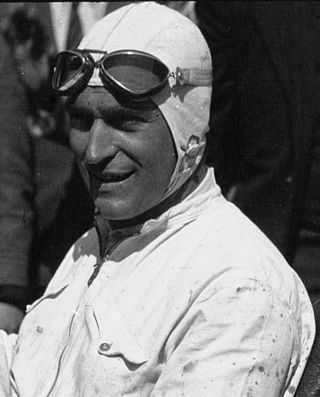
Luigi Cristiano Fagioli, nicknamed "the Abruzzi robber", was an Italian motor racing driver. Having won his last race at 53 years old, Fagioli holds the record for the oldest Formula One driver to win a race. He is also the only Formula One Grand Prix winner born in the 19th century, and the only Grand Prix racing driver to have won a championship race in both the AIACR European Championship and the World Drivers' Championship.

Baconin Borzacchini was an Italian Grand Prix motor racing driver often referred to as Mario Umberto Borzacchini.

The Grand Prix de la Marne was a motor race organized by the Automobile Club de Champagne and staged at the circuit Reims-Gueux on public roads located 7.5 km (4.7 mi) west of the city of Reims in the Marne département of north-eastern France. It proved to be one of the fastest and most prestigious road races in Europe.

Emilio Materassi was an Italian Grand Prix motor racing driver.

The 1937 Italian Grand Prix was a "750 kg Formula" Grand Prix race held on 12 September 1937 at the Montenero Circuit in Livorno.

Guillaume Laurent "Guy" Moll was a French racing driver.

The Coppa Florio was a motorsport race for automobiles first held in Italy in 1900. It was renamed in 1905 when Vincenzo Florio offered the initial 50,000 Lira prize money and a cup designed by Polak of Paris. The cup was to be awarded to the car maker who gained the most wins in the first seven races, beginning with the race held in 1905. In the event, the first seven races were all won by different manufacturers, but Peugeot won the eighth race in 1925 and thus secured the cup with its second win. However, the competition for the cup continued after Lucien Rosengart, then a director of Peugeot, offered to make it available again.

The Grand Prix of Naples was an auto racing event, held in Posillipo, in Naples.
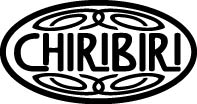
Chiribiri was an aircraft and automobile manufacturer in Turin Italy from 1910-1929. Fabbrica Torinese Velivoli Chiribiri & C.,, was founded by the Venetian Antonio Chiribiri, Maurizio Ramassotto and the engineer Gaudenzio Verga.

The 1932 Grand Prix season marked the second year of the AIACR European Championship. It saw the debut of Alfa Romeo's sensational new Tipo B and with it, Tazio Nuvolari won the Championship driving for the Alfa Corse works team. The 40-year old Nuvolari won two of the three rounds and was second in the other. Still running to a Formula Libre rules for the cars, the regulations were revised to set the races to be between five and ten hours. However, all three national committees ran their races to the minimum time-limit.

The Alfa Romeo Tipo 308 or 8C-308 is a Grand Prix racing car made for the 3 litre class in 1938. Only four cars were produced, actually modified from Tipo C with the engine mounted lower into the chassis and a slimmer body. The chassis was derived from the Tipo C and the engine from the 8C 2900. The 308 was engineered by Gioacchino Colombo under the control of Enzo Ferrari who was then in charge of Alfa's racing team, Alfa Corse. The car debuted at the Pau Grand Prix in 1938, where two cars were entered to race, one for Tazio Nuvolari and the other for Luigi Villoresi. Both drivers had to withdraw from competition, however Nuvolari had by then set a lap record. The next race was the Tripoli Grand Prix. The new 312 and 316 were entered, but they had engine trouble during practice and Clemente Biondetti took the start at the wheel of the 308 held in reserve. He failed to finish, while Hermann Lang, driving a Mercedes-Benz W154, was the winner. In this race, Eugenio Siena, driving a 312, was killed after hitting a wall.
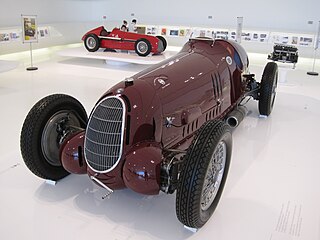
The Alfa Romeo 12C or Tipo C was a 12-cylinder Grand Prix car. The 12C-36 made its debut in Tripoli Grand Prix 1936, and the 12C-37 in Coppa Acerbo 1937. The 12C-36 was a Tipo C fitted with the new V12 instead of the 3.8 litre straight-eight of the 8C-35. The 12C-37 was a new car, with a lower chassis and an engine bored and stroked to 4475 cc, now with roller- instead of plain bearings and two smaller superchargers instead of a single large one. The car suffered poor handling, which could not be cured in time for the 1937 Italian GP, and thus was not successful. This is given as the reason for Vittorio Jano's resignation from Alfa Romeo at the end of 1937. The 12C-36 used the existing six Tipo C chassis. Four examples of the 12C-37 were built, although only two were actually assembled for the 1937 Coppa Acerbo and Italian GP. Early in 1938, the Tipo C chassis were modified into 308s, with the straight-eight engine fitted lower in the chassis and a completely new body. The four 12C-37 chassis were instead assembled into 312 and 316 formula race cars.
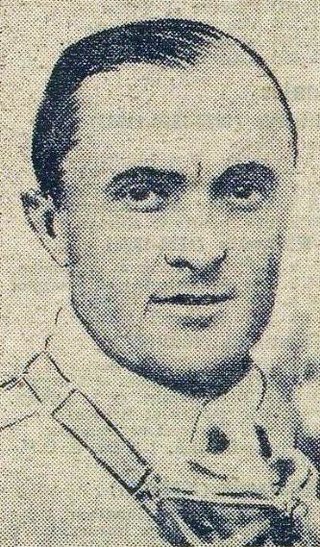
The 1928 Grand Prix season saw the Monegasque driver Louis Chiron, and his Bugatti, take seven Grand Prix victories.
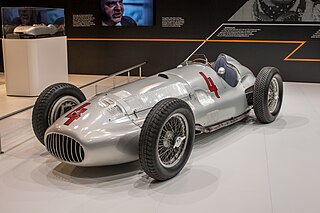
The Mercedes-Benz W154 was a Grand Prix racing car designed by Rudolf Uhlenhaut. The W154 competed in the 1938 and 1939 Grand Prix seasons and was used by Rudolf Caracciola to win the 1938 European Championship.
The 1929 Grand Prix season was another interim year, where most races were run to Formula Libre rules due to a lack of regulations from the AIACR that would be popular for race organisers and manufacturers. This blurred the line between racing cars and sports cars with both competing in the same races. Bugatti won the major international races, with their drivers Louis Chiron and "W Williams". The Italian Championship proved very competitive, attracting many top drivers. There it was Alfa Romeo, using their 4-year old P2 model that claimed more victories, than their main competition coming from Bugatti and Maserati.
The 1930 Grand Prix season continued the malaise that had taken over the sport. Although there was little technical advance more privateer teams were forming, getting some factory support. The AIACR continued to mandate its fuel-regulated Formula Libre rules. Across the Atlantic, the AAA abandoned the AIACR regulations. Their new regulations were derisively called the “Junk Formula” by purists, opening up to their own version of Formula Libre: with modified stock-standard cars of up to 366 cu in (6-litres) with two seats.

The Montenero Circuit, official name: Circuito del Montenero or sometimes referred to simply as "the Livorno Circuit", was a Grand Prix motor racing road course located at the southern outskirts of Livorno, a city on the mediterranean coast of the Tuscany region in Italy. The venue was best known as the home for the annual Circuito Montenero - Coppa Ciano and the 1937 Italian Grand Prix.

Charles Pierre Elie Montier was a French racing driver and automotive engineer whose race entries included the inaugural 24 Hours of Le Mans.

Ferdinand Montier (1909–1996) was a French racing driver active in Grand Prix motor racing.